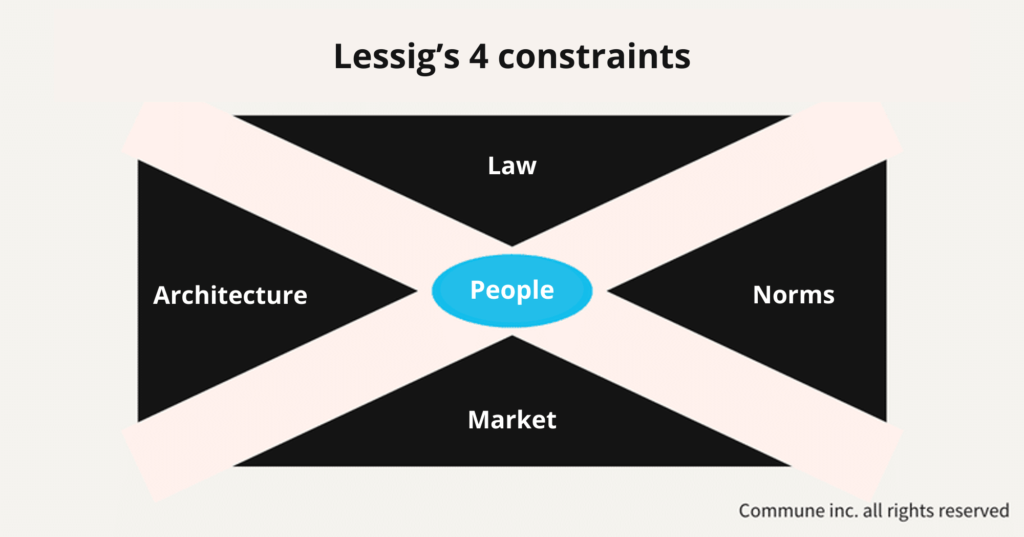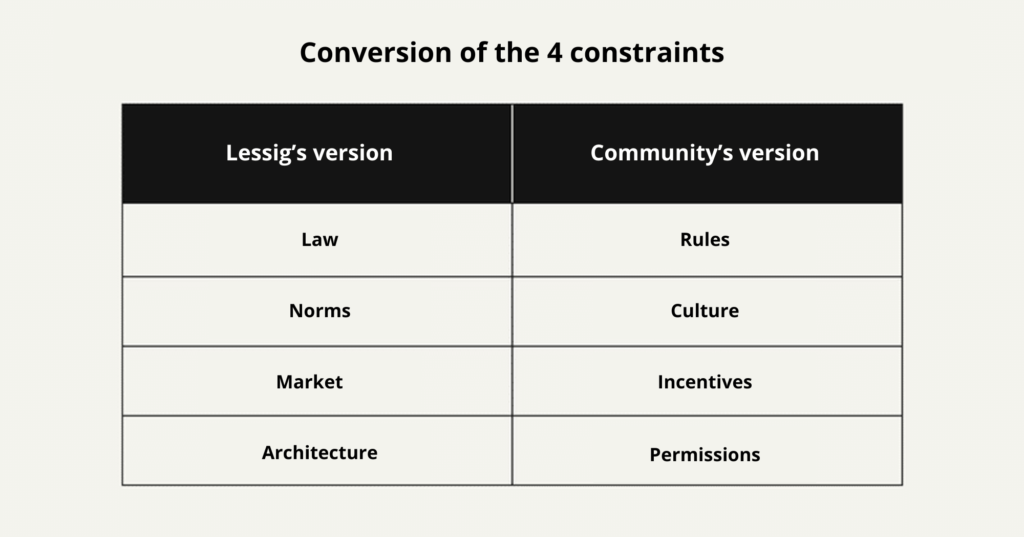
Recent research at the Commune Community Lab has focused on member motivation. As a result, findings such as “Driving Member Motivation: Autonomy, Competence, and Relatedness” and “Key Factors for Member Involvement in Community Management: Motivation, Ease of Execution, and Triggers” have been presented.
However, member actions are not solely triggered by individual psychological phenomena. This time, let’s shift our focus from the inside of the members to the outside.
What external environment determines the actions of members? In what environment can members enjoy the community more while community managers reap the benefits?
Summary:
Community members’ actions require freedom, while appropriate constraints are necessary. Lawrence Lessig’s four elements constraining behavior in society (law, norms, market, architecture) are applied to define four constraint elements in communities.
Properly designing and operating these elements can guide community member actions in desirable directions while promoting overall community activation.
Paradoxically, to enjoy freedom in a community, “constraints” are necessary. It’s often easier to take action within defined constraints than in a situation where anything goes.
For instance, in an online community where anything goes, it may paradoxically become difficult to generate posts. On the other hand, having a few predefined themes allows members to post freely within those constraints.
Even children’s play and sports rely on rules to function. Without constraints, people cannot fully enjoy their freedom. This is a generally accepted principle.
So, what are the elements that could constrain human behavior? Let’s delve deeper by drawing on the “4 constraints” outlined by Lawrence Lessig.

Lawrence Lessig, a global authority in cyber law, has been involved in shaping the new paradigm of copyright in the internet age through initiatives like “Creative Commons.” Besides his expertise in law, he has also discussed elements that constrain human action, aiming to realize a free society. These 4 elements are as follows:
Laws use the authority of the state to enforce sanctions as a means of constraint. For example, Article 235 of Japan’s Penal Code stipulates that theft, defined as “the act of taking another person’s property without permission,” is punishable by imprisonment for up to ten years or a fine of up to five hundred thousand yen.
“Imprisonment” deprives individuals of their freedom forcibly, while “fines” forcibly take away their property, both being disadvantages that everyone would want to avoid. To avoid these disadvantages, people refrain from stealing, for example, thus laws constrain people’s actions. The effectiveness of these constraints varies depending on whether laws have permeated into people’s consciousness.
In reality, laws often overlap with norms, making actions deemed illegal less socially acceptable. Conversely, actions considered undesirable according to norms may also be regulated by laws.
Norms utilize social sanctions from surrounding individuals as a means of constraint. For example, if someone steals another person’s belongings, they may be condemned as a “thief” by those around them and socially excluded. Similarly, even if one doesn’t go as far as stealing, eating a friend’s snack without asking for permission might lead to a negative reputation.
While norms are not as explicitly stated as laws, they constrain actions by making individuals conscious of the eyes of those around them when certain behaviors are not aligned with shared “desirable conduct” among a certain number of people.
As mentioned earlier, norms and laws often overlap, and the extent to which individuals perceive disadvantages determines whether they act within these constraints. However, there is a distinction in the entities imposing these constraints, whether it be governmental authorities or individuals within the community.
The market serves as another means of constraint. Specifically, it constrains people’s actions through the mechanism of price. For instance, for someone who wants to purchase a computer, whether they can obtain it or not depends on the price of the computer. If the price is set at 10 thousand dollars, the number of people willing to take the action of purchasing that computer will be very limited. Thus, the high price functions as a constraint on action.
Even if the price is low, if there are few available or one must wait in long queues to make a purchase, significant inconvenience can also constrain people’s actions.
Architecture refers to the manipulable environment. For example, the security system of a safe where valuables are stored constitutes architecture. The fact that someone without a key cannot physically remove a ring serves as a constraint on action.
Architecture is the most powerful means of constraint, as individuals do not necessarily need prior awareness of its existence, unlike laws or norms.
As a summary of the 4 constraints, let’s consider what constraints could be applied to reduce the action of “drunk driving.” Let’s think of this as a quiz-like exercise for now, setting aside whether it’s realistic or not.
How does that sound? Hopefully, the concept of people’s actions being determined by the 4 constraints has become clearer. Now, let’s steer the conversation back to the community.
Excessive constraints on members’ actions can leave a community feeling cold. However, appropriate constraints can ironically lead to greater freedom of action.
Since Lawrence Lessig’s 4 constraints carry a negative connotation of “imposing sanctions” and “making things impossible,” let’s transform them into a more positive framework suitable for communities and think about the 4 constraint conditions in the context of communities.
Analyzing the constraints under which people operate in society is what Lawrence Lessig’s 4 constraints are all about. By viewing communities as a specialized version of society, we should be able to create a new set of 4 constraint elements for communities. When each element is translated into the community context, it looks like this:

While there isn’t the same level of enforcement as with laws, communities have rules in place. These rules may not be as formal as norms, but each community cultivates its own culture as a way of doing things. Although not as open as markets, communities offer various rewards internally as incentives. While not as broad a concept as structure, community members are granted their own permissions.
These are the “4 constraint elements in the community.” Let’s consider how each element constrains or activates the actions of community members.
Rules refer to a list of explicit instructions like “do this” or “don’t do that.” Appropriate rules in a community have the following effects:
Appropriate rules contribute to the activation of the community by constraining members’ actions within a certain range while promoting order, purposefulness, and communication.
Culture refers to the shared implicit norms and tendencies in behavior among members. When a community fosters appropriate culture, it has the following effects:
Fostered culture contributes to the activation of community activities by implicitly constraining members’ actions while promoting values, creativity, and differentiation.
Incentives are various rewards (e.g., money, points, gratitude, approval) for members’ actions. When incentives exist in a community, they have the following effects:
The presence of incentives guides members’ actions in a certain direction while promoting motivation, competition, and action optimization, thereby contributing to the activation of community activities. However, it’s important to design incentives carefully to avoid excessive competition or feelings of unfairness.
Permissions refer to the access rights (e.g., ability to create event pages, post content) and titles (e.g., ambassador, director) granted to members. When appropriate permissions are given to members, it has the following effects:
Granted permissions constrain members’ actions within a certain range while promoting role clarification, autonomy, and leadership development, thereby contributing to the activation of community activities. However, careful consideration is needed in setting permissions to prevent excessive concentration of authority or its misuse.
We’ve considered “rules,” “culture,” “incentives,” and “permissions” as the 4 constraint elements of a community, but is that all? Let’s consider additional factors.
For example, the composition of members in a community also influences members’ actions. However, this can be seen as the formation of “culture” by the gathered members, which then constrains behavior.
Additionally, the degree of “connections” among members in a community also affects their actions. This, too, can be considered as emotional rewards and connections with other members serving as “incentives.”
While these factors may not comprehensively cover all aspects of constraints and activation in a community, they contribute to a framework that broadly captures the essence of a community.
We’ve explored the 4 elements that both constrain and activate communities. I hope this serves as a valuable reference for optimizing communication with members in community planning, event organization, content posting, and other activities!
Furthermore, I hope it prompts a reconsideration of the importance of establishing “rules,” nurturing “culture,” incorporating “incentives,” and granting “permissions” within communities.
For those seeking to enhance their community management processes, Commune’s strategic consulting service has successfully supported over 300 communities, from startups to established enterprises, in launching and managing their community initiatives. To learn more about how we can collaborate to enrich your community experience, book a demo today.